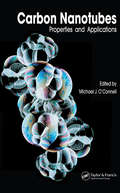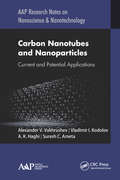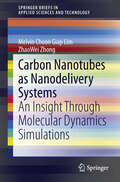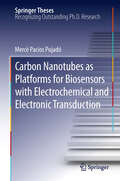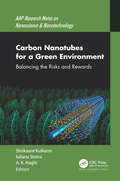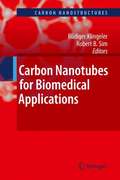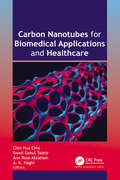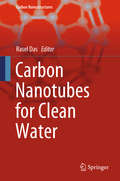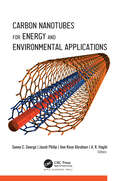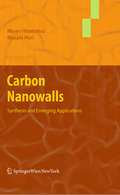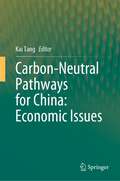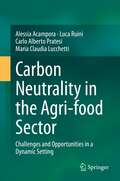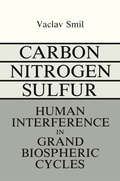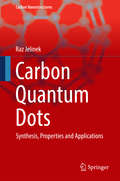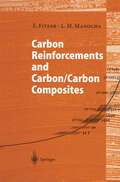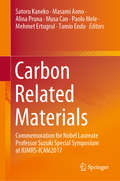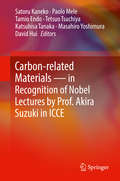- Table View
- List View
Carbon Nanotubes: Properties and Applications
by Michael J. O’ConnellSince their discovery more than a decade ago, carbon nanotubes (CNTs) have held scientists and engineers in captive fascination, seated on the verge of enormous breakthroughs in areas such as medicine, electronics, and materials science, to name but a few. Taking a broad look at CNTs and the tools used to study them, Carbon Nanotubes: Properties and Applications comprises the efforts of leading nanotube researchers led by Michael O’Connell, protégé of the late father of nanotechnology, Richard Smalley. Each chapter is a self-contained treatise on various aspects of CNT synthesis, characterization, modification, and applications. The book opens with a general introduction to the basic characteristics and the history of CNTs, followed by discussions on synthesis methods and the growth of “peapod” structures. Coverage then moves to electronic properties and band structures of single-wall nanotubes (SWNTs), magnetic properties, Raman spectroscopy of electronic and chemical behavior, and electromechanical properties and applications in NEMS (nanoelectromechanical systems). Turning to applications, the final sections of the book explore mechanical properties of SWNTs spun into fibers, sidewall functionalization in composites, and using SWNTs as tips for scanning probe microscopes. Taking a fresh look at this burgeoning field, Carbon Nanotubes: Properties and Applications points the way toward making CNTs commercially viable.
Carbon Nanotubes: Properties and Applications
by Michael J. O’ConnellSince their discovery more than a decade ago, carbon nanotubes (CNTs) have held scientists and engineers in captive fascination, seated on the verge of enormous breakthroughs in areas such as medicine, electronics, and materials science, to name but a few. Taking a broad look at CNTs and the tools used to study them, Carbon Nanotubes: Properties and Applications comprises the efforts of leading nanotube researchers led by Michael O’Connell, protégé of the late father of nanotechnology, Richard Smalley. Each chapter is a self-contained treatise on various aspects of CNT synthesis, characterization, modification, and applications. The book opens with a general introduction to the basic characteristics and the history of CNTs, followed by discussions on synthesis methods and the growth of “peapod” structures. Coverage then moves to electronic properties and band structures of single-wall nanotubes (SWNTs), magnetic properties, Raman spectroscopy of electronic and chemical behavior, and electromechanical properties and applications in NEMS (nanoelectromechanical systems). Turning to applications, the final sections of the book explore mechanical properties of SWNTs spun into fibers, sidewall functionalization in composites, and using SWNTs as tips for scanning probe microscopes. Taking a fresh look at this burgeoning field, Carbon Nanotubes: Properties and Applications points the way toward making CNTs commercially viable.
Carbon Nanotubes and Nanoparticles: Current and Potential Applications (AAP Research Notes on Nanoscience and Nanotechnology)
by Alexander V. Vakhrushev DSc Vladimir I. Kodolov A. K. Haghi Suresh C. AmetaThis new volume looks at significant new research, methodologies, and applications in the fields of carbon nanotubes and nanoparticles. It explores a variety of new developments in advanced carbon nanotubes and nanoparticles along with the tools to characterize and predict their properties and behavior. It introduces and reviews methods that are most frequently encountered in sophisticated nano-scaled materials domains, and helps to bridge the gap between classical analysis and modern real-life applications. A diverse array of topics in the field is addressed that provides many practical insights into nanocomposites and nanomaterials sciences.
Carbon Nanotubes and Nanoparticles: Current and Potential Applications (AAP Research Notes on Nanoscience and Nanotechnology)
by Alexander V. Vakhrushev Vladimir I. Kodolov A. K. Haghi Suresh C. AmetaThis new volume looks at significant new research, methodologies, and applications in the fields of carbon nanotubes and nanoparticles. It explores a variety of new developments in advanced carbon nanotubes and nanoparticles along with the tools to characterize and predict their properties and behavior. It introduces and reviews methods that are most frequently encountered in sophisticated nano-scaled materials domains, and helps to bridge the gap between classical analysis and modern real-life applications. A diverse array of topics in the field is addressed that provides many practical insights into nanocomposites and nanomaterials sciences.
Carbon Nanotubes as Nanodelivery Systems: An Insight Through Molecular Dynamics Simulations (SpringerBriefs in Applied Sciences and Technology)
by Melvin Choon Lim ZhaoWei ZhongThis book showcases the application of carbon nanotubes as nanodelivery systems for copper atoms, using molecular dynamics simulations as a means of investigation. The nanodelivery system of the carbon nanotube presents the possible usage of the carbon structure in many areas in the future. This book is comprehensive and informative, and serves as a guide for any reader who wishes to perform a molecular dynamics simulation of his own and to conduct an analytical study of a molecular system.
Carbon Nanotubes as Platforms for Biosensors with Electrochemical and Electronic Transduction (Springer Theses)
by Mercè Pacios PujadóThe thesis by Mercè Pacios exploits properties of carbon nanotubes to design novel nanodevices. The prominent electrochemical properties of carbon nanotubes are used to design diverse electrode configurations. In combination with the chemical properties and (bio)functionalization versatility, these materials prove to be very appropriate for the development of electrochemical biosensors. Furthermore, this work also evaluates the semiconductor character of carbon nanotubes (CNT) for sensor technology by using a field effect transistor configuration (FET). The CNT-FET device has been optimized for operating in liquid environments. These electrochemical and electronic CNT devices are highly promising for biomolecule sensing and for the monitoring of biological processes, which can in the future lead to applications for rapid and simple diagnostics in fields such as biotechnology, clinical and environmental research.
Carbon Nanotubes for a Green Environment: Balancing the Risks and Rewards (AAP Research Notes on Nanoscience and Nanotechnology)
by Shrikaant KulkarniCarbon Nanotubes for a Green Environment: Balancing the Risks and Rewards describes the synthesis, characterization, and unique applications of undoped and doped carbon nanotubes as well as hybrids of them with grapheme or nanocomposites, focusing on green aspects of carbon nanotube applications. The volume shows new approaches used for tapping the potential and promise of key materials in isolation or combined with other materials. The research-oriented chapters highlight a spectrum of applications of carbon nanotubes as novel materials for energy storage as well as for environmental remediation, wastewater treatment, green health care products, and more. Chapters explore the use of carbon nanotubes for remediation methods for wastewater treatment such as by using graphene oxide-carbon nanotube composites and by applying undoped and doped carbon nanotubes for removing contaminates. The book also looks at the application of carbon nanotubes for enhanced oil recovery and for heavy metal separation. Other chapters look at the rheological behavior of carbon nanotubes-based materials and their role in processing for various products, the thermal and electrical transport in carbon nanotubes composites, carbon nanotubes-based composite materials for electromagnetic shielding applications. The biomedical applications of carbon nanotube-based nanomaterials also explored, such as FTIR spectroscopy.
Carbon Nanotubes for a Green Environment: Balancing the Risks and Rewards (AAP Research Notes on Nanoscience and Nanotechnology)
by Shrikaant Kulkarni Iuliana Stoica A. K. HaghiCarbon Nanotubes for a Green Environment: Balancing the Risks and Rewards describes the synthesis, characterization, and unique applications of undoped and doped carbon nanotubes as well as hybrids of them with grapheme or nanocomposites, focusing on green aspects of carbon nanotube applications. The volume shows new approaches used for tapping the potential and promise of key materials in isolation or combined with other materials. The research-oriented chapters highlight a spectrum of applications of carbon nanotubes as novel materials for energy storage as well as for environmental remediation, wastewater treatment, green health care products, and more. Chapters explore the use of carbon nanotubes for remediation methods for wastewater treatment such as by using graphene oxide-carbon nanotube composites and by applying undoped and doped carbon nanotubes for removing contaminates. The book also looks at the application of carbon nanotubes for enhanced oil recovery and for heavy metal separation. Other chapters look at the rheological behavior of carbon nanotubes-based materials and their role in processing for various products, the thermal and electrical transport in carbon nanotubes composites, carbon nanotubes-based composite materials for electromagnetic shielding applications. The biomedical applications of carbon nanotube-based nanomaterials also explored, such as FTIR spectroscopy.
Carbon Nanotubes for Biomedical Applications (Carbon Nanostructures)
by Rüdiger Klingeler Robert B. SimThis book explores the potential of multi-functional carbon nanotubes for biomedical applications. It combines contributions from chemistry, physics, biology, engineering, and medicine. The complete overview of the state-of-the-art addresses different synthesis and biofunctionalisation routes and shows the structural and magnetic properties of nanotubes relevant to biomedical applications. Particular emphasis is put on the interaction of carbon nanotubes with biological environments, i.e. toxicity, biocompatibility, cellular uptake, intracellular distribution, interaction with the immune system and environmental impact. The insertion of NMR-active substances allows diagnostic usage as markers and sensors, e.g. for imaging and contactless local temperature sensing. The potential of nanotubes for therapeutic applications is highlighted by studies on chemotherapeutic drug filling and release, targeting and magnetic hyperthermia studies for anti-cancer treatment at the cellular level.
Carbon Nanotubes for Biomedical Applications and Healthcare
by Chin Hua Chia Swati Gokul Talele Ann Rose Abraham A. K. HaghiRecent advancements and research in nanotechnology, biotechnology, materials engineering the applications of nanomaterial are evolving. Carbon nanotubes (CNT) and CNT-based systems possess unique chemical, physical, and biological properties that make them good candidates in biomedical applications, but they also have some inherent properties that cause great concern about their biosafety. This volume explores the practical applications of carbon nanotubes in biomedical science and human health. It discusses the synthesis, properties, modification, and recent progress of carbon nanotubes and their applications for biosensing, cancer treatment, antibacterial therapy, tissue engineering, targeted drug delivery, and toxicity. It relays the potential and promise of carbon-based nanomaterials for host of applications while also looking at the challenges in synthesis, characterization, and applications of nanomaterials and how to overcome them.
Carbon Nanotubes for Biomedical Applications and Healthcare
Recent advancements and research in nanotechnology, biotechnology, materials engineering the applications of nanomaterial are evolving. Carbon nanotubes (CNT) and CNT-based systems possess unique chemical, physical, and biological properties that make them good candidates in biomedical applications, but they also have some inherent properties that cause great concern about their biosafety. This volume explores the practical applications of carbon nanotubes in biomedical science and human health. It discusses the synthesis, properties, modification, and recent progress of carbon nanotubes and their applications for biosensing, cancer treatment, antibacterial therapy, tissue engineering, targeted drug delivery, and toxicity. It relays the potential and promise of carbon-based nanomaterials for host of applications while also looking at the challenges in synthesis, characterization, and applications of nanomaterials and how to overcome them.
Carbon Nanotubes for Clean Water (Carbon Nanostructures)
by Rasel DasThis book presents carbon nanotubes as a potential material for the development of new waste water treatment technologies. Reviews on adsorption, catalysis, membrane, filtration and desinfection methods are provided. A special chapter presents the use of carbon nanotubes to sense and monitor water pollutants. The text underlies each technology and process as well as the current commercialization efforts. Research gaps are highlighted at the end with links to further reading material in the field.
Carbon Nanotubes for Energy and Environmental Applications
by Soney C. George Jacob Philip Ann Rose Abraham A. K. HaghiThis new book, Carbon Nanotubes for Energy and Environmental Applications, covers the timely issue of green applications of carbon nanotubes. It covers the diverse usages of carbon nanotubes for the sensing of environmentally hazardous chemicals, for water purification, for the protection of the environment, and for new energy applications. The development of highly sensitive CNT-based gas sensors for air pollution monitoring, for green synthesis of carbon nanotubes, and for green energy applications are discussed in this volume. The diverse topics in the volume include nanodiamonds for energy storage, new lubricant additives that enhance energy efficiency, how carbon nanotubes can be applied in the food and agricultural sectors, the use of CNTs in water purification and desalination, carbon nanotubes-based electrochemical sensors for environmentally hazardous chemicals, and much more. This timely book addresses a need of the hour and will provide valuable for environmentally conscious industry professionals, faculty and students, and researchers in materials science, engineering, physics, and chemistry with interest in nanomaterials.
Carbon Nanotubes for Energy and Environmental Applications
by Soney C. George Jacob Philip Ann Rose Abraham A. K. HaghiThis new book, Carbon Nanotubes for Energy and Environmental Applications, covers the timely issue of green applications of carbon nanotubes. It covers the diverse usages of carbon nanotubes for the sensing of environmentally hazardous chemicals, for water purification, for the protection of the environment, and for new energy applications. The development of highly sensitive CNT-based gas sensors for air pollution monitoring, for green synthesis of carbon nanotubes, and for green energy applications are discussed in this volume. The diverse topics in the volume include nanodiamonds for energy storage, new lubricant additives that enhance energy efficiency, how carbon nanotubes can be applied in the food and agricultural sectors, the use of CNTs in water purification and desalination, carbon nanotubes-based electrochemical sensors for environmentally hazardous chemicals, and much more. This timely book addresses a need of the hour and will provide valuable for environmentally conscious industry professionals, faculty and students, and researchers in materials science, engineering, physics, and chemistry with interest in nanomaterials.
Carbon Nanowalls: Synthesis and Emerging Applications
by Mineo Hiramatsu Masaru HoriRepresenting the first text to cover this exciting new area of research, this book will describe synthesis techniques of CNWs, their characterization and various expected applications using CNWs. Carbon-nanowalls (CNWs) can be described as two-dimensional graphite nanostructures with edges comprised of stacks of plane graphene sheets standing almost vertically on the substrate. These sheets form a wall structure with a high aspect ratio. The thickness of CNWs ranges from a few nm to a few tens of nm. The large surface area and sharp edges of CNWs may prove useful for a number of applications such as electrochemical devices, field electron emitters, storage materials for hydrogen gas, catalyst support. In particular, vertically standing CNWs with a high surface-to-volume ratio, serve as an ideal material for catalyst support for fuel cells and in gas storage materials.
Carbon-Neutral Fuels and Energy Carriers (Green Chemistry and Chemical Engineering)
by Nazim Z. Muradov T. Nejat VeziroǧluConcerns over an unstable energy supply and the adverse environmental impact of carbonaceous fuels have triggered considerable efforts worldwide to find carbon-free or low-carbon alternatives to conventional fossil fuels. Carbon-Neutral Fuels and Energy Carriers emphasizes the vital role of carbon-neutral energy sources, transportation fuels, and a
Carbon-Neutral Fuels and Energy Carriers (Green Chemistry and Chemical Engineering)
Concerns over an unstable energy supply and the adverse environmental impact of carbonaceous fuels have triggered considerable efforts worldwide to find carbon-free or low-carbon alternatives to conventional fossil fuels. Carbon-Neutral Fuels and Energy Carriers emphasizes the vital role of carbon-neutral energy sources, transportation fuels, and a
Carbon-Neutral Pathways for China: Economic Issues
by Kai TangThis book provides comprehensive economic analyses on the paths to net-zero for China. It gives a detailed overview of issues and challenges related to carbon neutrality of the global largest emitter which have not been adequately addressed e.g., reduction costs and efficiency of existing actions, the multiple impacts of the newly established carbon market, and the potentials and costs of nature-based solutions such as biophysical sequestration, etc. Studies on China’s carbon reduction have attracted scientists and policymakers from diverse backgrounds. Pursuing a holistic and systematic approach, the book establishes a fundamental framework for this topic, emphasizing the importance of integrated technical-economic-policy analysis. This book will not only be an essential reference to the carbon-neutral progress in China but also will be an outstanding text book on carbon-neutral management. Similarly, this book is expected to attract a great range of readership including undergraduate and postgraduate students, economic and climate specialists, researchers and policymakers in China as well as in overseas.
Carbon Neutrality in the Agri-food Sector: Challenges and Opportunities in a Dynamic Setting
by Alessia Acampora Luca Ruini Carlo Alberto Pratesi Maria Claudia LucchettiThis book deals with the in-depth study of sustainability issues in the agri-food sector. In particular, a critical analysis of the current situation was developed and the future prospects of the sector on the issue of managing the environmental variable and the impacts relating to food production and consumption have been analyzed. Furthermore, the state of implementation and best practices relating to the carbon neutrality model in the agri-food sector were analyzed and models for the development of a new food production system were proposed with particular reference to the reduction of emissions, regeneration of natural resources, the elimination of waste and the reuse of production by-products. The main objectives of the book are to analyze the current situation and trends regarding carbon neutrality schemes and the connection with other greening programs, to identify and analyze the carbon-related labels, their methodology and their conformity assessment mechanisms and to understand possible key drivers for carbon neutrality or low carbon achievements in the agri-food sector.Today companies are acting on climate change pressures implementing carbon-neutral strategies for their brands and products. These frontrunner companies have identified a specific competitive advantage and are exploiting it to become the pioneers and the reference model for the carbon neutral implementation. This book will provide detailed and practical insights on how your organization can take positive action and be part of the global response developing a carbon neutral business.
Carbon Neutrality Science: A Theoretical and Technical Framework and Energy Development Strategies
by Caineng ZouThis book focuses on the connotation and extension of carbon neutrality. It presents a full collection of various topics in carbon neutrality, including carbon production, reduction, utilization, storage, capture, markets, and society, etc. It concludes that carbon neutrality is the pathway to global green and low-carbon sustainable development and the foundation for building harmonious ecological civilization. This book is a valuable reference for researchers, practitioners, and policy-makers in the field of earth and environmental sciences.
Carbon-Nitrogen-Sulfur: Human Interference in Grand Biospheric Cycles (Modern Perspectives in Energy)
by V. Smilica, I considered myself an old hand: when I started to study the environment of the North Bohemian region in 1963, the ecosystemic changes and health effects result ing from extremely high concentrations and deposition of sulfurous and nitrogenous air pollutants and particulate matter could not be ignored. When I returned to the area in 1966 to work there for nearly three years as a consultant in energy and environmental affairs, I came to realize the difficulties of efficiently controlling the problem. Hiking on the crest of the Ore Mountains overlooking the valley, I saw much destruction and degradation of coniferous plantings-but I was also repeatedly surprised by the contrast of the withering tops and stunted dried-out growth of spruces and firs with the magnificent beech trees and the healthy understory of shrubs and wild flowers. I recall this impressive lesson of ecosystemic vulnerability and resistance every time I read sweeping generalizations about the environmental effects of acid deposition. At the same time, in the second half of the 1960s, I was introduced by a friend, an engineer working in analytical chemistry and biochemistry, to some of the mysteries of enzymes; this led me to nitrogenase, one of the most incredible sub stances on this planet, and to an interest in various aspects of the nitrogen cycle, which was further strengthened by my later work on the energy cost of crop production, involving inevitable comparisons between natural nitrogen fixation and Haber-Bosch ammonia synthesis.
Carbon Quantum Dots: Synthesis, Properties and Applications (Carbon Nanostructures)
by Raz JelinekThis book introduces the various aspects of the emerging field of carbon dots. Their structural and physico-chemical properties as well as their current and future potential applications are covered. A special chapter on graphene quantum dots is provided. The reader will also find different synthesis routes for carbon quantum dots.
Carbon Reinforcements and Carbon/Carbon Composites
by E. Fitzer Lalit M. ManochaAdvanced composite materials have been a major research focus for the past forty years. As a reinforcement for conventional materials including glass, ceramics and polymers, carbon has proved to be the most successful. Carbon gives these materials flexibility so that they may be produced in bulk form with a wide variety of properties. Whereas carbon/carbon composites are the most effective materials in extreme temperature conditions. Application ranges from brakes to missile nose cones. Carbon Reinforcements and Carbon/Carbon Composites gives the present state on this subject in comprehensive form, as well as projections for other "High Tech" materials and their application.
Carbon Related Materials: Commemoration for Nobel Laureate Professor Suzuki Special Symposium at IUMRS-ICAM2017
by Satoru Kaneko Masami Aono Alina Pruna Musa Can Paolo Mele Mehmet Ertugrul Tamio EndoThis book commemorates the “Nobel Laureate Professor Suzuki Special Symposium” at the International Union of Material Research Society–International Conference on Advanced Materials (IUMRS-ICAM2017), which was held at Kyoto University, Japan, in 2017. The book begins with a foreword by Professor Akira Suzuki. Subsequently, many authors who attended the special symposium describe the latest scientific advances in the field of carbon materials and carbon nanomaterials including polymers, carbon nanocomposites, and graphene. Carbon-based materials have recently been the focus of considerable attention, given their wide range of potential applications. Fittingly, the chapters in this book cover both experimental and theoretical approaches in several categories of carbon-related materials.
Carbon-related Materials in Recognition of Nobel Lectures by Prof. Akira Suzuki in ICCE
by Satoru Kaneko Paolo Mele Tamio Endo Tetsuo Tsuchiya Katsuhisa Tanaka Masahiro Yoshimura David HuiThis book summarizes the recent advances in carbon-related materials. It covers both experimental and theoretical approaches in graphene and nanocarbon materials, carbon composites and thin films, organic synthesis and physical chemistry, and characterization tools. Also discussed are cutting-edge applications for use in biochemical assays, dental implant surface modifi cations, pressure sensors, and more. This book is published in recognition of the Nobel Lectures delivered by Akira Suzuki, Emeritus Professor of Hokkaido University and Nobel Prize winner in Chemistry, 2010.
